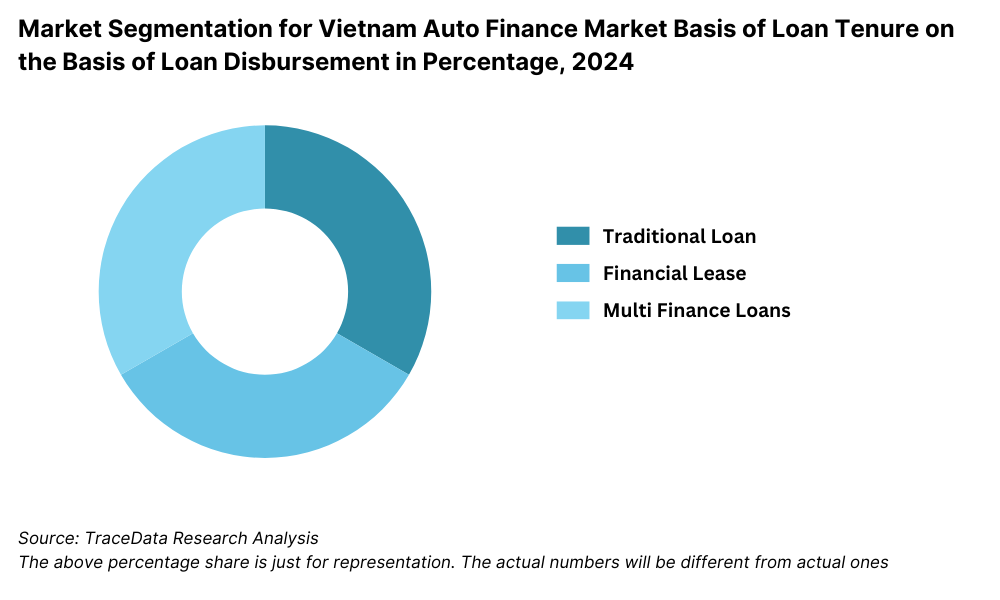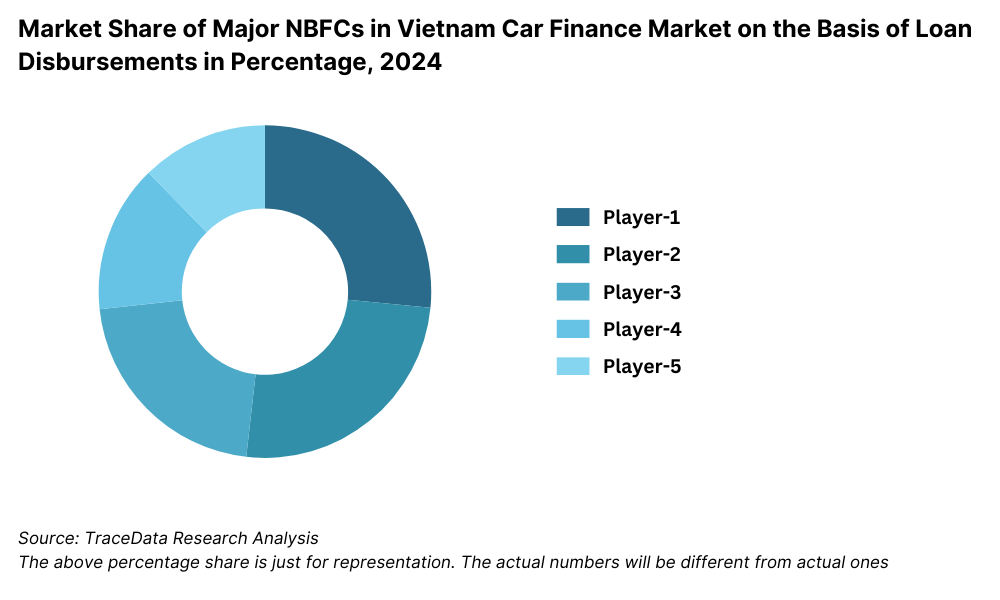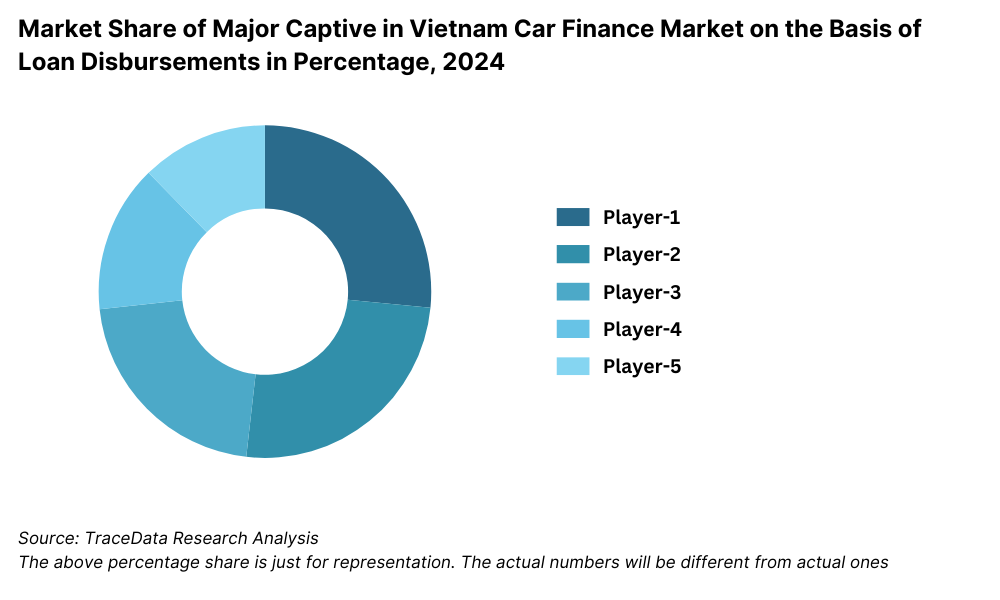Vietnam Auto Finance Market Outlook to 2029
By Market Structure, By Lenders, By Loan Tenure, By Vehicle Type, By Consumer Demographics, and By Region
- Product Code: TDR0127
- Region: Asia
- Published on: April 2025
- Total Pages: 110
Introducing the World's FirstPay-Per-Section Market Reports
Why pay for the full report when you need just a part?
Start Building Your Report
Scroll down to see available sections
Report Summary
The report titled "Vietnam Auto Finance Market Outlook to 2029 – By Market Structure, By Lenders, By Loan Tenure, By Vehicle Type, By Consumer Demographics, and By Region" provides a comprehensive analysis of the auto finance industry in Vietnam. The report covers an overview and genesis of the industry, overall market size in terms of loan disbursement, market segmentation; trends and developments, regulatory landscape, customer profiling, issues and challenges, and comparative landscape including competition scenario, cross-comparison, opportunities and bottlenecks, and company profiling of major players in the auto finance market. The report concludes with future market projections based on loan disbursement, by market, product types, region, cause and effect relationship, and success case studies highlighting major opportunities and cautions.
Vietnam Auto Finance Market Overview and Size
The Vietnam auto finance market reached a valuation of VND 400 trillion in 2023, driven by the rising demand for automobile ownership, increasing disposable income, and the growing preference for financing solutions. The market is characterized by key players such as VPBank, Techcombank, VIB, MB Bank, HD Saison, Toyota Financial Services, and Shinhan Finance, which dominate the sector with competitive loan offerings, digital financing solutions, and extensive dealer partnerships.
In 2023, VPBank launched a digital auto loan service to simplify the loan application and approval process, targeting younger and tech-savvy consumers. Major cities such as Ho Chi Minh City, Hanoi, and Da Nang lead the market due to their high population density, strong automotive infrastructure, and increasing vehicle ownership trends.
Market Size for Vietnam Auto Finance Industry Based on Loan Disbursement in USD Billion, 2018-2024

What Factors are Leading to the Growth of the Vietnam Auto Finance Market?
Economic Factors: The increasing price of new vehicles and the growing middle-class population have significantly contributed to the demand for auto financing. In 2023, auto loans accounted for nearly 70% of total vehicle purchases in Vietnam, as they allow buyers to spread payments over time instead of making large upfront payments. Competitive loan interest rates ranging from 7% to 12% have also encouraged vehicle ownership through financing.
Growing Middle Class: Vietnam’s expanding middle-class segment, growing by 15% over the past five years, is increasingly opting for auto financing solutions. This demographic shift has resulted in an increasing number of first-time car buyers who rely on financial institutions to make vehicle purchases affordable. With rising disposable incomes, consumers are willing to take on longer loan tenures (up to 84 months) to acquire their preferred vehicles.
Digitalization: The rise of digital auto loan applications and AI-driven credit assessments has transformed the auto finance industry, making loan approvals faster, more transparent, and convenient. In 2023, approximately 45% of auto loan approvals in Vietnam were processed through digital platforms, reflecting a strong shift toward online lending solutions. Fintech collaborations with banks and automakers have further strengthened the digital auto financing ecosystem, allowing for more seamless lending experiences.
Which Industry Challenges Have Impacted the Growth of Vietnam Auto Finance Market?
High Credit Risk: A significant portion of Vietnam's population remains unbanked or underbanked, making it difficult for lenders to assess creditworthiness. Approximately 30% of auto loan applications face rejection due to insufficient credit history, impacting overall market expansion.
Fluctuating Interest Rates: Economic factors such as inflation and monetary policy adjustments can lead to fluctuations in auto loan interest rates. In 2023, interest rates on auto loans increased by 1.5%, making financing less affordable for some consumers.
Regulatory Constraints: The State Bank of Vietnam (SBV) enforces strict loan-to-value (LTV) ratios and debt-to-income (DTI) requirements, limiting the amount of financing available to consumers. These regulations aim to control debt levels but can also reduce accessibility to auto loans for some buyers.
What are the Regulations and Initiatives that Have Governed the Market?
Loan-to-Value (LTV) Ratio Regulations: The Vietnamese government has established maximum LTV ratios for auto loans, requiring buyers to make a minimum down payment. In 2023, the average LTV ratio was capped at 70%, meaning consumers had to cover at least 30% of the vehicle's price upfront.
Digital Lending Policies: The government supports fintech and digital banking initiatives to improve auto finance accessibility. In 2023, new guidelines were introduced to regulate digital loan platforms, ensuring transparency and consumer protection.
Tax Incentives for Electric Vehicles (EVs): To encourage EV adoption, the government has introduced reduced registration fees, tax exemptions, and special financing options for electric cars. These incentives have boosted EV financing by 25% in 2023, making sustainable vehicle ownership more affordable.
Vietnam Auto Finance Market Segmentation
By Market Structure: The banking sector dominates the Vietnam auto finance market due to its large customer base, trust factor, and competitive interest rates. Leading banks such as VPBank, Techcombank, and VIB provide auto loans with flexible repayment options and digital loan approvals, making them a preferred choice among consumers. Non-banking financial institutions (NBFIs) also hold a significant share as they offer higher loan approval rates and cater to customers with limited credit history. Captive finance companies like Toyota Financial Services and Shinhan Finance specialize in financing specific car brands, providing customized loan packages to enhance affordability.

By Loan Tenure: Loans with a tenure of 48 to 60 months dominate the market as they offer a balance between affordability and manageable monthly payments. Consumers prefer this range as it allows them to purchase higher-value vehicles while keeping monthly payments within their budget. Shorter loan tenures of 12 to 36 months are favored by high-income earners and corporate buyers, who prefer quicker repayment to minimize interest costs.

By Vehicle Type: New car financing dominates the market as banks and financial institutions offer lower interest rates and higher loan-to-value (LTV) ratios for brand-new vehicles. Consumers prefer financing new cars due to warranty coverage and lower maintenance costs. Used car financing accounts for a smaller yet growing share, driven by the increasing demand for affordable vehicle ownership. However, higher interest rates and shorter loan tenures in this segment limit its expansion compared to new car financing.
Competitive Landscape in Vietnam Auto Finance Market
The Vietnam auto finance market is relatively concentrated, with a mix of leading banks, non-banking financial institutions (NBFIs), and captive finance companies playing a dominant role. However, the rise of fintech platforms and digital lending services has diversified the market, providing consumers with more options for vehicle financing.
Key Players in the Vietnam Auto Finance Market
| Name | Founding Year | Original Headquarters |
| Toyota Financial Services Vietnam | 2008 | Tokyo, Japan |
| FE Credit (VPBank Finance Company) | 2010 | Ho Chi Minh City, Vietnam |
| Home Credit Vietnam | 2008 | Prague, Czech Republic |
| Shinhan Vietnam Finance | 2019 | Seoul, South Korea |
| HD SAISON Finance | 2007 | Ho Chi Minh City, Vietnam |
| JACCS International Vietnam Finance | 2010 | Tokyo, Japan |
| Techcombank Finance | 1993 | Hanoi, Vietnam |
| Prudential Vietnam Finance Company (PVFC) | 2007 | Ho Chi Minh City, Vietnam |
| Vietcombank Finance Leasing Company | 1998 | Hanoi, Vietnam |
| Vietnam International Leasing Company (VILC) | 1997 | Hanoi, Vietnam |
Recent Competitor Trends and Key Information about Major Players
VPBank: As one of the leading banks in the auto finance sector, VPBank processed over VND 120 trillion in auto loans in 2023, marking a 15% growth from the previous year. The bank’s emphasis on digital lending, AI-driven credit scoring, and partnerships with car dealerships has strengthened its position in the market.
Techcombank: Focused on high-value auto financing, Techcombank reported a 20% increase in loans for premium and luxury vehicles in 2023. The bank’s collaborations with high-end automobile brands such as Mercedes-Benz and BMW have made it a preferred choice for affluent customers.
VIB: A market leader in providing low-interest auto loans and flexible repayment plans, VIB saw a 17% rise in loan disbursement for new vehicles in 2023. The bank's digital-first approach, offering instant online loan approvals, has contributed to its rapid expansion.
MB Bank: MB Bank continues to expand its auto finance portfolio, recording a 12% growth in 2023. The bank has invested in AI-driven risk assessment technology, enabling faster loan approvals and reduced default risks.
HD Saison: Specializing in used car financing and installment-based loan schemes, HD Saison witnessed a 22% rise in used car loans in 2023. The company’s partnerships with second-hand car dealerships have played a crucial role in its success.
Toyota Financial Services: As the captive finance arm of Toyota, the company facilitated financing for over 45% of Toyota car buyers in Vietnam in 2023. Its brand-specific financing schemes and customized loan packages make it a strong competitor in the market.



What Lies Ahead for Vietnam Auto Finance Market?
The Vietnam auto finance market is projected to grow steadily by 2029, exhibiting a respectable CAGR during the forecast period. This growth is expected to be driven by economic expansion, increasing vehicle ownership, and advancements in digital lending solutions.
Shift Towards Electric Vehicle (EV) Financing: As the Vietnamese government continues to promote eco-friendly transportation, the demand for EV financing is expected to rise. Government incentives such as reduced registration fees and tax exemptions for EV purchases are likely to boost financing options for electric vehicles, leading to a significant expansion of green auto loans by 2029.
Advancements in Digital Lending: The integration of AI, machine learning, and blockchain technology in loan processing and credit assessment will enhance loan approval speeds and risk assessment accuracy. Digital financing platforms are expected to dominate the market, with over 60% of auto loans projected to be disbursed through online channels by 2029.
Expansion of Used Car Financing: The used car financing segment is anticipated to witness substantial growth, fueled by the rising demand for affordable vehicle ownership. As lenders introduce more competitive interest rates and longer loan tenures for used cars, this market segment is expected to gain significant traction over the next five years.
Increased Role of Fintech in Auto Finance: Fintech companies are likely to play a pivotal role in reshaping the auto finance landscape, offering instant loan approvals, AI-driven credit scoring, and alternative financing models. Their ability to cater to young, tech-savvy consumers will contribute to a more inclusive lending environment.
Future Outlook and Projections for Vietnam Car Finance Market on the Basis of Loan Disbursements in USD Billion, 2024-2029


Vietnam Auto Finance Market Segmentation
By Market Structure:
Banks
NBFCs
Captives
By Financing Options:
Traditional Bank Loans
Multi-Finance Loans
Leasing
By Type of Vehicles:
New Vehicles
Used Vehicles
Electric Vehicles
By Age of Consumer:
18-34
35-54
55+
By Region:
Hanoi (Capital city)
Ho Chi Minh City (Largest city, formerly Saigon)
Hai Phong
Da Nang
Can Tho
Nha Trang
Hue
Vung Tau
Da Lat
Players Mentioned in the Report (Banks):
Bank for Investment and Development of Vietnam (BIDV)
Vietcombank
Sacombank
Techcombank
Shinhan Bank
Vietnam International Commercial Joint Stock Bank (VIB)
Vietinbank
Tien Phong Bank (TPBank)
Players Mentioned in the Report (NBFCs):
HD SAISON Finance Co., Ltd
Mirae Asset
Home Credit
FE Credit
Players Mentioned in the Report (Captive):
Toyota Financial Services Vietnam Company Limited
BMW Financial Services
Key Target Audience:
- Commercial Banks
- Non-Banking Financial Institutions (NBFIs)
- Car Dealerships & Automotive Manufacturers
- Digital Lending Platforms & Fintech Companies
- Government & Regulatory Bodies (e.g., State Bank of Vietnam)
- Research and Development Institutions
Time Period:
- Historical Period: 2018-2023
- Base Year: 2024
- Forecast Period: 2024-2029
Report Coverage
Choose individual sections to purchase. Mix and match as you like.
- -
- -
- $100
4.1. Value Chain Process-Role of Entities, Stakeholders, and challenges they face.
4.2. Relationship and Engagement Model between Banks-Dealers, NBFCs-Dealers and Captive-Dealers-Commission Sharing Model, Flat Fee Model and Revenue streams
4.3. Supply Decision-Making Process
$2505.1. New Car and Used Car Sales in Vietnam by type of vehicle, 2018-2024
$150- $100
- $200
8.1. Credit Disbursed, 2018-2024
8.2. Outstanding Loan, 2018-2024
$3009.1. By Market Structure (Bank-Owned, Multi-Finance, and Captive Companies), 2023-2024P
9.2. By Financing Options (Traditional Loans, Leasing, Multi-Finance Loans), 2023-2024P
9.3. By Cities, 2023-2024P
9.4. By Type of Vehicle (New, Used, Electric), 2023-2024P
9.5. By Average Loan Tenure (0-2 years, 3-5 years, 6-8 years, Above 8 years), 2023-2024P
$40010.1. Customer Landscape and Cohort Analysis
10.2. Customer Journey and Decision-Making
10.3. Need, Desire, and Pain Point Analysis
10.4. Gap Analysis Framework
$50011.1. Trends and Developments for Vietnam Car Finance Market
11.2. Growth Drivers for Vietnam Car Finance Market
11.3. SWOT Analysis for Vietnam Car Finance Market
11.4. Issues and Challenges for Vietnam Car Finance Market
11.5. Government Regulations for Vietnam Car Finance Market
$20012.1. Market Size and Future Potential for Online Car Financing Aggregators, 2018-2029
12.2. Business Model and Revenue Streams
12.3. Cross Comparison of Leading Digital Car Finance Companies Based on Company Overview, Revenue Streams, Loan Disbursements/Number of Leads Generated, Operating Cities, Number of Branches, and Other Variables
$50013.1. Finance Penetration Rate and Average Down Payment for New and Used Cars, 2018-2029
13.2. How Finance Penetration Rates are Changing Over the Years with Reasons
13.3. Type of Car Segment for which Finance Penetration is Higher
$250- $250
- $250
- $150
17.1. Market Share of Key Banks in Vietnam Car Finance Market, 2023
17.2. Market Share of Key NBFCs in Vietnam Car Finance Market, 2023
17.3. Market Share of Key Captive in Vietnam Car Finance Market, 2023
17.4. Benchmark of Key Competitors in Vietnam Car Finance Market, including Variables such as Company Overview, USP, Business Strategies, Strengths, Weaknesses, Business Model, Number of Branches, Product Features, Interest Rate, NPA, Loan Disbursed, Outstanding Loans, Tie-Ups and others
17.5. Strengths and Weaknesses
17.6. Operating Model Analysis Framework
17.7. Gartner Magic Quadrant
17.8. Bowmans Strategic Clock for Competitive Advantage
$75018.1. Credit Disbursed, 2025-2029
18.2. Outstanding Loan, 2025-2029
$30019.1. By Market Structure (Bank-Owned, Multi-Finance, and Captive Companies), 2025-2029
19.2. By Financing Options (Traditional Loans, Leasing, Multi-Finance Loans), 2025-2029
19.3. By Region, 2025-2029
19.4. By Type of Vehicle (New, Used, Electric), 2025-2029
19.5. By Average Loan Tenure (0-2 years, 3-5 years, 6-8 years, above 8 years), 2025-2029
19.6. Recommendation
19.7. Opportunity Analysis
$400
Research Methodology
Step 1: Ecosystem Creation
Map the ecosystem and identify all demand-side and supply-side entities for the Vietnam Auto Finance Market. Based on this ecosystem, we will shortlist leading 5-6 financial institutions in the country based on their financial information, loan disbursement volume, and market presence.
Data sourcing is conducted through industry articles, multiple secondary sources, and proprietary databases to perform desk research and collect industry-level information.
Step 2: Desk Research
Conduct comprehensive desk research by referencing diverse secondary and proprietary databases to gather and analyze market information.
The research covers aspects such as loan disbursement trends, interest rates, the number of financial players, lending policies, demand patterns, and regulatory landscape.
Additionally, we conduct an in-depth review of company-level data, relying on sources such as press releases, annual reports, financial statements, and regulatory filings to develop a foundational understanding of market dynamics and key entities.
Step 3: Primary Research
Initiate in-depth interviews with C-level executives and key stakeholders from leading banks, non-banking financial institutions (NBFIs), fintech platforms, and auto dealerships.
These interviews aim to validate market hypotheses, authenticate statistical data, and extract operational and financial insights from industry representatives.
A bottom-up approach is undertaken to assess loan disbursement volume for each financial institution, which is then aggregated to calculate the overall market size.
Step 4: Sanity Check
- Perform top-down and bottom-up market size modeling exercises to cross-validate research findings and ensure data accuracy. Conduct a final assessment to confirm the alignment of market estimates with historical trends, industry growth projections, and expert opinions.
FAQs
1. What is the potential for the Vietnam Auto Finance Market?
The Vietnam auto finance market is expected to grow significantly, reaching a valuation of VND 700 trillion by 2029. This growth is driven by rising vehicle ownership, increasing disposable incomes, and the expansion of digital lending solutions. The market’s potential is further enhanced by government incentives for electric vehicle (EV) financing and the adoption of fintech-based auto loan platforms that simplify the loan approval process.
2. Who are the Key Players in the Vietnam Auto Finance Market?
The Vietnam Auto Finance Market features several key players, including VPBank, Techcombank, VIB, and MB Bank, which dominate the market due to their extensive loan offerings and digital financing solutions. Other notable players include HD Saison, Toyota Financial Services, and Shinhan Finance, which cater to brand-specific and high-income customer segments.
3. What are the Growth Drivers for the Vietnam Auto Finance Market?
The primary growth drivers include economic expansion, increasing vehicle ownership, and advancements in digital lending solutions. The growing middle-class population in Vietnam, coupled with rising disposable incomes, is leading to an increased demand for auto loans to finance vehicle purchases.
4. What are the Challenges in the Vietnam Auto Finance Market?
The Vietnam Auto Finance Market faces several challenges, including high credit risk and limited financing accessibility for certain consumer segments. A significant portion of the population remains unbanked or underbanked, making it difficult for lenders to assess creditworthiness and approve loans.